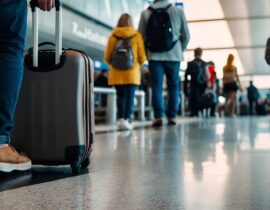Airplane accidents are limited in numbers, thanks to far-reaching safety initiatives maintained by airports and pilots. The magnitude of large-scale air disasters calls for fortifications in the way safe air travel is managed, so stringent regulations are enforced to keep the process as safe as possible.
High safety standards are in place at every level of the airline industry, most occurring behind closed doors, unknowingly to the passengers who depend on them. When even the slightest breakdown occurs, danger is amplified among air travelers.

Covering All the Air Safety Bases
Automobile maintenance is significantly more forgiving than the requirements in-place for keeping aircraft in regular flight. The safety requirements applied to air travel are reinforced proportionally, to reflect the inherent dangers present when flying. While your automotive breakdown my result in inconvenience, aircraft failure ends in mass casualties and inconceivable damage to property. As a result, no stone is left unturned in the quest for 100% safe air travel.
Strict maintenance and inspection schedules govern airplane use, ensuring that every vessel taking to the skies is worthy of the task. Technically demanding standards are applied to each aircraft evaluation, before pass or fail grades are given to each essential flight system. Renewable parts are replaced according to established timetables, which swap used components for new ones, long before their useful lives are up. Each essential system is broken-down, and looked over, with an eye toward mechanical shortcomings. Even the slightest irregularities provide sufficient cause to ground an airplane, until further review can be conducted.
Landing and take-off are the most dangerous moments of each flight, so landing gear and other components used during these critical processes receive fine toothed comb treatment. Technicians inspect not only primary systems, but also those backups put in-place to hedge against mechanical breakdowns. Gauges and instruments are calibrated and checked for accuracy, against known standards. Clearance for travel is not given until every aircraft feature receives a passing grade.
Where and Why Airplanes Crash
Despite the dangers present in flight, the most frequent airplane accidents do not occur in midair. Ground travel, during take-off, landing, and taxiing, is more problematic than cruising at high altitudes, because of the number of hazards present on the ground. Service vehicles, fuel and baggage trucks, as well as other airplanes, make for congested ground conditions, which increase the likelihood for vehicle contact.
The impact planes sustain upon landing, and the transition from air speed to safe landing speeds, also contributes to heightened danger as planes come in. Overall air travel safety hinges on ground conditions too, including the integrity of runway pavement, and accuracy of lighting systems.
Airports maintain their own standards, but are also subject to government regulations, which dictate how operations facilities must be maintained.
Accidents occurring in midair are the results of mechanical failure, operator error, or contact with foreign objects. Catastrophic airplane crashes result from errors occurring in air, and on the ground. Air-traffic controllers are charged with managing large volumes of planes in the air, contributing to one of the tensest vocations available. Despite safety regulations governing the profession, mistakes nonetheless happen, leading to injuries and damage to property. When controllers misguide planes, the consequences of contact between crafts results in mass injuries and death.
Crafts also hit birds in flight, stimulating damage to jet engines, and leading to accidents. When geese and other large birds are drawn into spinning jet turbines, they cause extensive damage, often disabling engines. While some outcomes are positive, loss of engines can be an end-all while flying.







